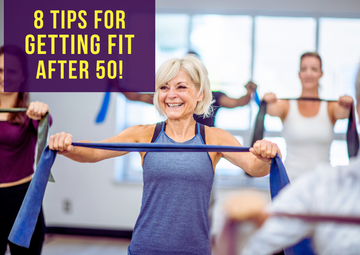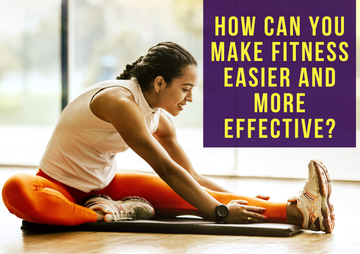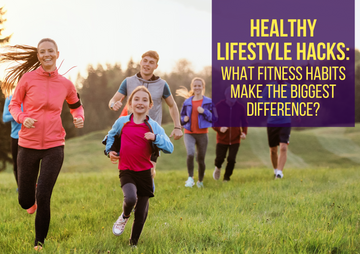8 Tips for Getting Fit After 50!
Staying active in your fifties and beyond may be the finest investment you can offer yourself.
One of the most essential reasons to exercise after the age of 50 is to help you maintain a healthy weight reducing blood pressure, while boosting your levels of energy. It may even help you avoid a few of the signs of aging and is beneficial to your overall physical health and mental well being.
There are numerous methods to be active over the age of 50, whether you wish to maintain your current weight or feel much more energized and generally healthier.
Before you gather your jug of water and gear bag, we urge you to consult with your physician before beginning a new workout plan or making modifications to an existing one.
A well-rounded exercise program, according to experts, should include three components:
Aerobic Activity, Strength Training, and Stretching.
Aerobic activity: Aim for three or four 20-minute periods of aerobic activity each week that keeps your heart racing. As previously stated, during aerobic activity, you should be at 50 to 85 percent of your maximal heart rate.
Aerobic activities to consider include brisk walking, running, swimming, dancing, cycling, water aerobics, hiking, skiing, heavy gardening, jumping rope, stair climbing, tennis, rowing, and kayaking.
Strength training: Strength training allows you to maintain or increase muscular density while decreasing your risks of back injury. Begin with light weights and progress to 12 reps by doing eight easy repeats. This should help you increase strength as well as improve your posture.
Muscular strength reduces with age, thus strength training is essential for preserving strength and preventing muscular atrophy in those over the age of 50. Strength training has also been found to improve bone density and slow the pace of bone disintegration, lowering the risk of fractures later on in life.
Stretching as well as warm-ups: Should be incorporated into your regimen to increase joint mobility and lessen the chance of injury or tension. Stretching improves posture, relieves muscular tension and relieves discomfort.
However, if done consistently, it minimizes the chance of injury and enhances blood circulation and muscle function.
Stretching every day does not have to take that long: a five-minute stretching regimen can avoid long-term injury. It's essential to concentrate on your hamstrings, quadriceps, hips, spine, core, shoulders. Alternatively, stretching arts such as yoga have been shown to actively enhance lifespan and flexibility in our bodies. Yoga also combats both mental and physical health decline. Yoga practice can minimize fall-related injuries while also providing pain relief and greater flexibility. Ensure to stretch slowly!
It is never too late to start!
Often people who begin exercising in their forties or fifties are discouraged because they believe that it is too late to get substantial advantages. This is not true. According to research, it is never too late to begin reaping the advantages of exercise. In this article, we will walk you through several tips on how to get started:
Be Consistent:
Because it is based on your current level of health and fitness, fitness goals, and whether you have any health concerns, there is no set method for estimating how much exercise you need to undertake.
Each week, 150 minutes of moderate exercise or 75 minutes of vigorous aerobic activity, each session lasting at least 10 minutes, can still bring considerable health benefits!
Get Walking!
Walking is the greatest exercise for anyone over the age of 50, according to experts. Walking, as easy as it is, is the most fundamental, universal workout that almost everyone can do.
Walking is equally as healthy as any other kind of cardio and is the greatest way to start with an exercise routine. Walking has the same health advantages as more strenuous sports like jogging.
You can attain the advantages faster with for instance, running, however the advantages are the same. Your heart rate increases: Check and double-check that your legs are working and that you are exercising all of your muscles.
The components are all present, yet walking is the most accessible and least harmful form of physical activity for older people. Most people can walk, and it's connected with decreased risks of injury, she adds. It's far gentler on the joints than many other workouts since it's low-impact (as opposed to jogging, which involves pounding the pavement).
Sit Less and Move More.
Understanding you should move more might be intimidating, especially if you're just getting started. Some people don't believe they could fit in the recommended amount of physical exercise, so they stop moving completely.
However, those suggestions are only guides. It doesn't have to be either/or. Instead of being more active, try to become less sedentary. For example, you do not have to meet the target of 10,000 steps per day in a week, however this could be the objective to achieve over the course of two to three months.
Take it Slow at First.
If you're out of shape, it's easy to get disheartened at first. Begin with short, attainable objectives, such as walking for 20-30 minutes most days of each week, and gradually include more activity into your schedule.
According to analysts, a small dosage of exercise' can make a significant difference in your overall health.
Maintain Variety.
If you're tired of your typical routine, do something new. Some individuals believe that they should only practice 'senior-only' activities, but if you're able to perform more intense kinds of exercise safely, you should do what you are comfortable with.
This might be anything from an aerobics class to cycling, swimming, or dancing, gardening, washing the car, hiking, golf, cricket, going down and up the stairs, or brisk walking are all examples of physical activity. If you have any worries about what you can safely perform, see your doctor.
Monitor your Heart Rate.
Track your goal heart rate to ensure that your workouts aren't too simple or difficult.
Subtraction of your age from 220 gives you your maximum heart rate per minute.
During moderate aerobic activity, you can anticipate to be at 50 to 70% of your cardiovascular endurance, while intense exercise should be at 70 to 85% of your maximum heart rate.
You may also use the discussion rule to determine whether your activity is too strenuous.
When you begin with moderate activity, you should feel somewhat exhausted but able to maintain a conversation for at least thirty minutes. As you advance to more severe activity, it will become more difficult to speak in whole phrases between breaths.
Please keep in mind that these are merely guidelines; if you do have any questions, visit your doctor. If you use heart-rate-lowering drugs, talk to your doctor about recording your heart rate during workouts.
Keep an Eye out for Issues.
If you're just starting out with exercise or have a chronic condition, take it slowly at first. If you use pain medication, see your doctor before beginning your new workout regimen.
Back discomfort, joint difficulties, arthritis, and osteoporosis are all frequent fitness obstacles as you become older. If you have a chronic ailment, see our specialist about exercising safely, although in many situations, you may expect some normal muscle discomfort when you first begin exercising. Most types of exercise do have potential to help with these conditions, whether by enhancing bone density or muscle strength.
Find a Workout Buddy!
When you workout with a buddy or your partner, you are more likely to exercise on a regular basis since you have someone to coax you. Working out a friend motivates people to stick with a goal for longer than they would on their own and help give each other fantastic encouragement and keep people to stick with it for longer than they would on their own.
When you're out for a run, running alongside others boosts your safety as well.
It's always safer to have a trust worthy buddy alongside you!
Frequently Asked Questions
How much activity would you need after the age of 50?
At least 150 minutes per week of moderate intensity activity (for example, 30 minutes per day, 5 days per week) such as brisk walking. Alternatively, they require 75 minutes of vigorous-intensity action each week, such as hiking, running, or walking. At least two days each week of muscle-strengthening exercises.
Can you change your physique after the age of 50?
You can gain muscle at any age, although it's definitely the most significant strategy to get in shape beyond 50. Strength and resistance training is important as we age for a variety of reasons, but it ultimately boils down to stronger muscles, stronger bones, fewer injuries.
Do you grow weaker as you get older?
After the age of 50, you begin to lose muscle mass at a quicker rate. Physical strength might deteriorate as well. Lifting weights or doing strength training activities like squats and lunges 2 to 3 times per week is the greatest approach to arrest this decline.
How long does it take for a 50-year-old to gain muscle?
Once it comes to witnessing the physical consequences of your strength training and nutrition plan, many fitness professionals agree that this will take about a few weeks. Six to nine weeks of strength training should result in an increase in muscle growth if you workout consistently.
And Lastly:
Exercising does not need extended hours of agony and suffering in exchange for insignificant returns. Most essential, your workout should allow you to focus only on yourself. Remember that exercise has been shown to improve your mood for many years.
It helps you see the side of things by increasing the release of hormones that influence your happiness. Serotonin reduces anxiety and promotes calm. Exercise is another fantastic technique to feel less weary. No, seriously! It fights exhaustion by activating endorphin release, rather than causing you to feel more fatigued. This hormone has a natural stimulating effect.
RESTCLOUD Neck and Shoulder Relaxer, for TMJ Pain Relief
TRAINED Premium Quality Badminton Rackets, Pair of 2 Rackets
Amazfit Band 7 Fitness & Activity Tracker, Step Monitoring, Heart Rate & SpO2 Monitoring
Check out our previous articles!
10 Benefits Of Working Out With A Friend!
How a 10 Minute Walk Can Improve Your Overall Well Being
6 Light Stretches to Help You Sleep Better
5 Simple Stretches to Relieve Lower Back Pain
What Are The Health Benefits of Swimming?
8 Simple Tips to Declutter Your Space and Your Mind


























